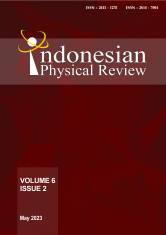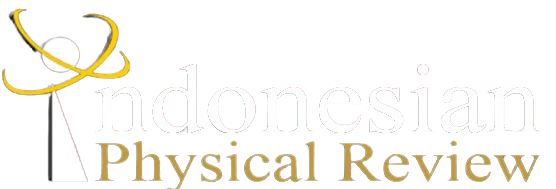MICROZONING OF HAZARD VULNERABLE USING MICROSEISMIC METHOD WITH HVSR (HORIZONTAL TO VERTICAL SPECTRAL RATIO) ANALYSIS IN BAYAT DISTRICT, KLATEN, INDONESIA
DOI:
10.29303/ipr.v6i2.206Downloads
Abstract
The Yogyakarta earthquake in 2006 caused damage in several areas, especially in the area of Klaten Regency. As a result, many infrastructures, houses, health facilities and casualties have been damaged. The research was conducted with the target of knowing the level of earth's hazard by microzoning soil vulnerability areas in the Bayat District, Klaten, Central Java. This study used the microseismic method with the HVSR (Horizontal to Vertical Spectral Ratio) analysis method. Where are the natural/dominant frequency parameters, natural amplification, and earthquake vulnerability index as measured parameters? This study aims to carry out microzonation of disaster vulnerability risks which are interpreted from the results obtained, namely amplification maps (A0), dominant frequency (f0), earthquake vulnerability (Kg), and shear wave velocity maps at a depth of 30 meters (Vs30). Data acquisition was carried out at 19 measurement points with a spacing between points having a distance of 1-2 km using a portable TDS seismograph. The acquisition results obtained varied values with A0 values 0.9 – 8.8, f0 values 1.0 – 13.8 Hz, Kg values 0.4 – 38.5, and Vs30 values 228.1 – 1635.4 m/s. From these results it can be categorized as zoning regarding the value of the level of disaster vulnerability based on the value of earthquake vulnerability (Kg) obtained to minimize damage and casualties
Â
Keywords:
Bayat , Vs30, HVSR, Mikroseismik, f0, A0, KgReferences
Arifin, S.S., B.S. Mulyanto, Marjiyono, & R. Setianegara. 2012. Penentuan Zona Rawan Guncangan Bencana Gempa Bumi berdasarkan Analisis Nilai Amplifikasi HVSR Mikrotremor dan Analisis Periode Dominan Daerah Liwa dan Sekitarnya. Jurnal Geofisika Eksplorasi Vol. 2, No. 1.
BPS Klaten, 2010. Buku Putih Sanitasi Klaten. Badan Pusat Statistik Kabupaten Klaten
Daryono. 2011. Indeks Kerentanan Seismik Berdasarkan Mikrotremor pada Setiap Satuan Bentuklahan di Zona Graben Bantul, Daerah Istimewa Yogyakarta. Disertasi. Program Pascasarjana Fakultas Geografi. Universitas Gadjah Mada. Yogyakarta
Luthfiana, D P. 2022. Mengenang 16 Tahun Gempa Yogyakarta 27 Mei 2006. https://www.kompas.com/tren/read/2022/05/27/073358965/hari-ini-dalam-sejarah-mengenang-16-tahun-gempa-yogyakarta-27-mei 2006?page=all#:~:text=KOMPAS.com%20%2D%20Hari%20ini%2016,dan%20ribuan%20orang%20meninggal%20dunia. Dikutip pada tanggal 5 Desember 2022.
Gurler, E.D., Y. Nakamura, J. Saita, & T. Sato. 2000. Local site effect of Mexico City based on microtremor measurement. 6thInternational Conference on Seismic Zonation. Palm Spring Riviera Resort. California, USA, pp.65
Huang, H.C. & Tseng,Y.S. (2002). Characteristics of soil liquefaction using H/V of microtremorsin Yuan-Lin Area, Taiwan. TAO, Vol. 13, No. 3, 325-338, September 2002.
Ibrahim, Gunawan, dan Subardjo. 2005. Pengetahuan Seismologi. Jakarta: Badan Meteorologi dan Geofisika.
Jaya W. E. & Sungkono. 2013. Estimasi Indeks KerentananTanah Menggunakan Metode HVSR (Horizontal toVertical Spectral Ratio). Jurnal Sains dan Seni Pomits2(1): 2337-3520.
Marjiyono. 2010. Estimasi Karakteristik Dinamika Tanah Dari Data Mikrotremor Wilayah Bandung. Thesis ITB. Bandung
Mufida dkk (2013), "Profiling Kecepatan Gelombang Geser Vs Surabaya Berdasarkan Pengolahan Data Mikrotremor", Jurnal Sains Dan Seni Pomits, Vol.2.
Nakamura, Y. 1989. A Method for Dynamic Characteristic Estimation of Subsurface using Microtremor on The Ground Surface. Q.R. of RTRI. Vol.30, No. 1, page 25-33.
Nakamura, Y. 1997. Seismic Vulnerability Indices for Ground and Structures using Microtremor. World Congress on Railway Research: Florence.
Nakamura, Y. 2000. Clear Identification of Fundamental Idea of Nakamura’s Technique and Its Application. The 12nd Word Conference on Earthquake Engineering. Tokyo, Japan
Nakamura, Y. 2008. On The H/V Spectrum. The 14th World Conference on Earthquake Engineering. Beijing, China.
Saita, J., M.L.P. Bautista, & Y. Nakamura. 2004. On Relationship Between The Estimated Strong Motion Characteristic of Surface Layer and The Earthquake Damage -Case Study at Intramuros, Metro Manila. Paper No. 905, 13th World Conference on Earthquake Engineering, Vancouver, B.C.Canada.
Slob, S., 2007, Micro Seismic Hazard Analysis, Earthquake Vulnerability and Multi-Hazard Risk Assessment: Geospatial Tools for Rehabilitation and Reconstruction Efforts, ITC The Netherlands.
SNI 1726. 2012. Tata Cara Perencanaan Ketahanan Gempa untuk Struktur Bangunan Gedung dan Non Gedung.
Surono, B. Toha, dan I. Sudarno. 1992. Peta Geologi Lembar Surakarta-Giritontro. Bandung : Pusat Penelitian dan Pengembangan Geologi
License

This work is licensed under a Creative Commons Attribution-NonCommercial-ShareAlike 4.0 International License.
Authors who publish with Indonesian Physical Review Journal, agree to the following terms:
- Authors retain copyright and grant the journal right of first publication with the work simultaneously licensed under a Creative Commons Attribution-ShareAlike 4.0 International Licence (CC BY SA-4.0). This license allows authors to use all articles, data sets, graphics, and appendices in data mining applications, search engines, web sites, blogs, and other platforms by providing an appropriate reference. The journal allows the author(s) to hold the copyright without restrictions and will retain publishing rights without restrictions.
- Authors are able to enter into separate, additional contractual arrangements for the non-exclusive distribution of the journal's published version of the work (e.g., post it to an institutional repository or publish it in a book), with an acknowledgment of its initial publication in Indonesian Physical Review Journal.
- Authors are permitted and encouraged to post their work online (e.g., in institutional repositories or on their website) prior to and during the submission process, as it can lead to productive exchanges, as well as earlier and greater citation of published work (See The Effect of Open Access).





